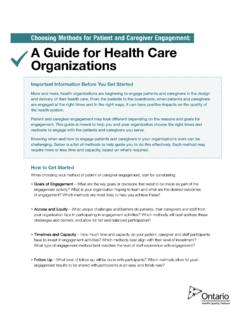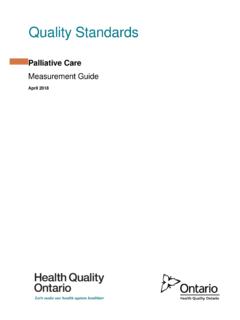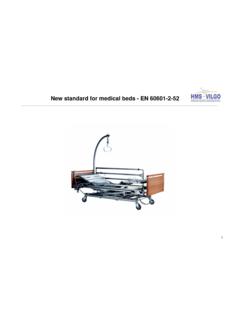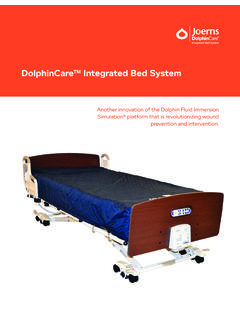Transcription of Why we need a quality standard for Opioid Use …
1 W H Y W E N E E D A Q U A L I T Y S TA N D A R D F O R. Palliative care i n Ontario Less than 60% of the people who die in Ontario have a record of having received palliative care services during their final 12 months of life. Palliative care relieves suffering and improves the quality of living and dying for people with a life-limiting illness. Earlier palliative care can lead to better quality of life,1, 2 and palliative-specific home care has been associated with a 50% reduction in the likelihood of dying in home visits by a health care provider and home care services are two examples of the many important components of excellent palliative care . In Ontario, during their final 30 days of 56% 28% People living in the poorest neighbourhoods People living in the wealthiest neighbourhoods of people of people receive 52% receive home care receive palliative-specific 60% receive home care home care home care 23% receive 32% receive palliative-specific palliative-specific home care home care Just under one quarter of In 2015/16, there was up to a fivefold difference between regions of Ontario in the percentage of people who had a Ontarians receive a home visit physician home visit in their last month of life.
2 From a physician in the month before their death. 19%. io t st t st t an a t n l l n oe on ir tra tra es as es es Br ar la to ai ar Ea Ea ka c gt W. W. lW..C. pl lE. en en d ag t al nt ko im lin m H. th h tra C. C. th h O. an Ni St tra us S. ut ha el ut or ga or o en M orth So W. m n ie en So N. nt C. N. di o au Er C. al ilt o ro C. iss N. lo H m To er a iss H. at M. W. Local Health Integration Network (LHIN) Region Most people in Ontario Together, we can improve the quality of care f or adults with a life-limiting illness still die in hospital, who are considering palliative care . although this percentage D E AT H S IN H OS PITA L S *. That's why Health quality Ontario in collaboration 57%.
3 Has decreased. in with health care providers, and patients' families and caregivers has developed this quality 2011/12 standard outlining what quality care looks like. 54% in Most people would prefer to die a t home . Physician home visits a 4,5. nd 2015/16. palliative home care visits during the last year of life are associated w ith a *Hospital deaths include deaths in acute care beds, complex continuing lower risk of dying in hospital. 3,6 care beds and emergency departments. 1. Zimmermann C, Swami N, Krzyzanowska M, Hannon B, Leighl N, Oza A, et al. Early palliative care for patients with advanced cancer: a cluster-randomised controlled trial. Lancet. 2014;383:1721 30. 2. Bacon J. The palliative approach: improving care for Canadians with life-limiting illnesses [Internet].
4 Ottawa (ON): Canadian Hospice Palliative care Association; 2012. Available from: 3. Bainbridge D, Seow H, Sussman J, Pond G, Barbera L. Factors associated with not receiving homecare, end-of-life homecare, or early homecare referral among cancer decedents: a population-based cohort study. Health Policy. 2015;119:831 9. 4. Health quality Ontario. Palliative care at the end of life [Internet]. Toronto (ON): Queen's Printer for Ontario; 2016 [cited 2016 Aug 19]. Available from: /0/documents/system- 5. Residential Hospice Working Group. Environmental scan for strengthening residential hospice care in Ontario, evidence and practice [Internet]. Toronto (ON): Hospice Palliative care Ontario;. 2015 [cited 2016 Aug 19].
5 Available from: 6. Tanuseputro P, Beach S, Chalifoux M, Wodchis W, Hsu A, Seow H, Manuel D. Associations between physician home visits for the dying and place of death: a population-based retrospective cohort study. PLoS ONE. 2018; 13(2):e0191322. ISBN 978-1-4868-1722-1 (PDF) Queen's Printer for Ontario, 2018.














